Meet the scientists and conservationists fighting to save the Northwest’s forests from an invasive plant.
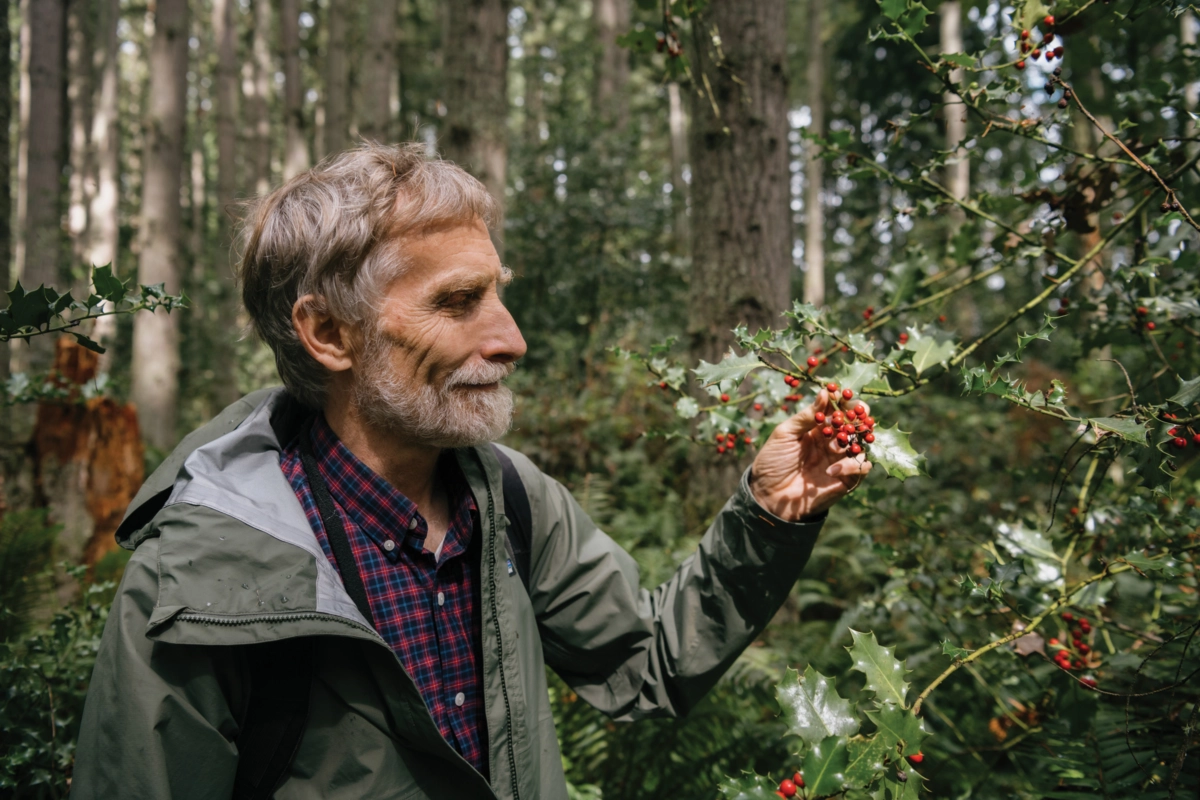
Henry Mustin popped open the trunk of his electric Volkswagen to reveal his arsenal: Loppers, pruners, saws and trowels, tucked into bags. Taking up the most space was Mustin’s weed wrench, an L-shaped specialty tool branded The Extractigator, which leverages the ground to yank deeply rooted vegetation from the earth.
We were in the parking lot of Island Center Forest, a 440-acre wooded park home to miles of hiking trails and one large pond where birdwatchers flock. Island Center Forest is on Vashon Island, southwest of Seattle. Mustin’s summer home is on Vashon, and my partner and I have a small farm here.
We were looking for English holly, a cherished Christmas symbol that is threatening biodiversity in the Pacific Northwest. We were there to poison it.
Perhaps nobody in the state of Washington has killed more holly trees than Mustin. After a long career as a doctor, Mustin retired in 2013 and began dedicating several days a week to bushwacking deep into the woods to destroy the plant he loathes.
We hiked through a tunnel of greenery: Douglas firs towered above and sword ferns fanned around our feet. It was a mild day in July, and Mustin, wearing long sleeves and work pants, worked up a sweat. At 75, he is a discursive thinker and talker, answering questions before I could ask them.
“Start looking for where the contrast in the vegetation stands out,” he said. Holly’s dark green leaves and red berries pop against the forest’s lighter hues. We climbed over downed branches, dodged stinging nettles and stomped across carpets of trailing native blackberry.
We walked until we found a tree not already flagged for removal by county workers. Standing at about 20 feet tall, its many branches were lined with alternating leaves, each shaped like a “POW!” bubble in a comic strip, oval with serrated edges. The reds and greens were unmistakably Christmassy. The trunk split into a v-shape, the thicker sub-trunk reaching toward a nearby alder as if it wanted a hug.
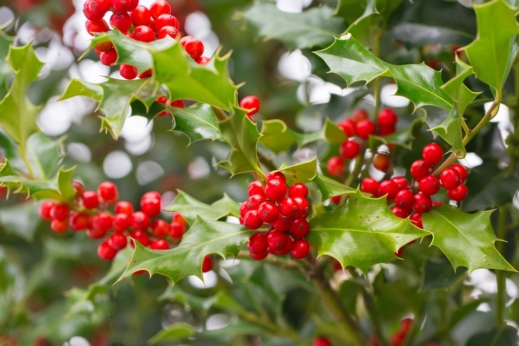
English holly’s green and red appearance evokes the Christmas holiday. (Photo: Shutterstock)
Mustin knelt and dug into his backpack, pulling out a plastic tube containing .22-caliber shells he’d purchased online from a forestry supply store in Colorado. Mustin’s shells contained a heavy concentration of tarry black imazapyr, an herbicide favored by weed technicians as the best—really, the only—method for tackling big holly efficiently.
Most people who inject holly with herbicide-filled shells use a specialized spring-loaded lance called an EZ-Ject. To avoid alarming anyone, Mustin left his EZ-Ject in the trunk with the weed wrench. “It’s kind of like walking into the park with a pickax or a shovel,” he said. Instead, we’d have to Macgyver today’s application.
Some might accuse Mustin of committing a misdemeanor—herbiciding without a license. Mustin would argue that he still operates as an “arm” of the Washington Department of Natural Resources, which supervised his holly-killing sprees from 2015 to 2022, when he led volunteers on restoration excursions. Today he mostly works independently, finding solo missions more efficient, though the state still occasionally supplies him with herbicide equipment and he maintains permission to work on state land.
Using pliers, he carefully lifted an imazapyr-filled shell and pressed its open end against the holly. With a tack hammer in his other hand, he tap-tap-tapped the shell into the wood, repeating this process every four inches around the tree. He stopped halfway; I finished the other half, completing a collar of shells around the trunk.
Over the next few weeks, the tree would absorb the imazapyr, which would travel through its vascular system, slowly killing it. “By the fall, there may not be many leaves left on there at all,” Mustin assured me.
We made plans to return.
VASHON ISLAND, at less than 40 square miles, accounts for a tiny percentage of the hollies invading the Pacific Northwest. English holly has roots in parks and forests from Vancouver Island to the Willamette Valley. Municipal watersheds, private timberlands and tribal nations have all contended with it, and it’s become widely established in the lowlands of Olympic National Park.
There are more than 500 species of holly, but only the English variety (Ilex aquifolium) threatens Northwestern ecosystems. In its native range—Europe, West Asia and Northern Africa—English holly can grow upward of 80 feet tall, but the tallest known specimens in the United States hover around 50 feet. Conservationists are less worried about holly’s height, however, than they are about its spread.
Under human control, holly can be shaped and shifted to meet our needs for beauty and privacy. Cut through a holly stem, and several new limbs will eventually emerge. Wander through a Northwest neighborhood, and you might see holly hedges meticulously shaped into sharp-edged boxes.
Some of the same qualities that make holly such a desirable landscaping plant also make it a ruthless invader. It can live for a century, withstand considerable damage and thrive in the shade. It also reproduces prolifically; many parts of one tree can make new hollies.
Holly’s shallow root system spawns new growths through a process called suckering, in which holly fledglings, connected to their parent’s network, shoot out of the ground. Dozens of holly suckers can emerge from a single root system. Over time, some suckers develop their own root systems and strike out on their own, emerging as independent plants.
Holly branches can also produce new hollies. Lower branches on taller trees often sag groundward, brushing the soil. Given enough moisture, roots can grow from just about any point of contact, supporting a new holly stem in a process called layering. If something in the woods—a falling branch or an animal—severs the connecting shoot, you’ve got a new holly tree.
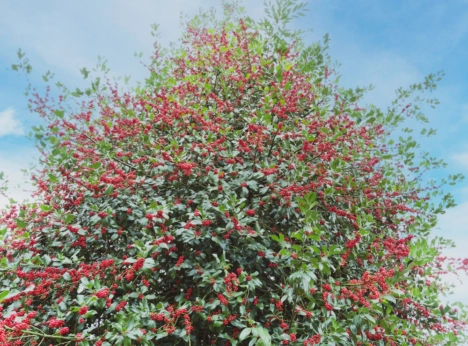
The tallest known specimens of English holly in the United States hover around 50 feet. (Photo: Shutterstock)
Suckering and layering often produce dense thickets, which suppress native plants, reduce visibility for wildlife, and haunt conservationists. But roots and branches can spread holly only so far.
Long-distance travel requires the collaboration of bird and berry. The red of ripe holly berries, somewhere between Kool-Aid and blood, beckons birds like a well-lit diner at night. The cold-hardy berries must look especially tasty in wintertime, when other foods are scarce.
When robins find holly berries, they split into teams. One team dive-bombs the berry bonanza, picking fruit at a speedy clip. The others watch for predators from nearby trees. Fruit in tow, a feeding robin retreats to a relay perch for lookout duty, allowing its flockmates to take their turn at the buffet. The robin digests its meal while keeping guard. Processing berry pulp, from beak to butt, takes about 15 minutes, though, contrary to popular belief, most holly seeds do not depart through droppings. Instead, they go down and up again, exiting via mouth, one-by-one, like Pez.
During a feeding frenzy, robins can regurgitate holly seeds more than 150 feet from the source. If a predator— say, a hawk—interrupts the meal, the birds may scatter nearly a third of a mile before expelling their seeds.
Viable seeds can take years to sprout, but once they do, the resulting sapling has the potential to grow into a mature tree capable of suckering and layering. If the tree happens to be a female near a male, it will one day produce berries.
“IT’S ONE OF THOSE THINGS that, once you see it, you start seeing it everywhere,” said David Stokes, a former ecologist at the University of Washington Bothell and perhaps the foremost expert on invasive holly in the Northwest.
Stokes, a fit 70-year-old, has kind eyes and a professorial beard. As a doctoral student at the University of Washington, he studied the migration patterns of Magellanic penguins in Patagonia. Later, his focus shifted to urban ecology. As a professor at Sonoma State University, he dabbled in invasive plants as faculty advisor for a student conservation group, leading field trips to a creek where they removed the notorious tree of heaven (Ailanthus altissima).
After returning to the Seattle area in 2006 to teach at the UW Bothell, north of his alma mater, Stokes spent a lot of time at St. Edward State Park. Walking in the shade of alders and maples, Stokes noticed clusters of English holly in the understory, something he knew did not belong. Alarmingly, the non-native shrub appeared to be thriving in a mature forest, contrary to the prevailing scientific view.
When the study of invasive plants took off in the ’80s and ’90s, scientists focused on the fast-growing, sun-loving species that overrun grasslands, farms and disturbed or logged forests. Ecologists thought intact forests were largely immune to such invasions.
Scientists began publicly questioning this assumption in the mid-aughts. In a frequently cited 2009 paper in the journal Frontiers in Ecology, a trio of researchers identified more than 139 shade-tolerant plants that have invaded deeply shaded forests. The authors theorized that the relatively slow growth of these plants lulled scientists into “ignoring their potentially severe and long-term impacts on forest ecosystems worldwide.”
By the time Stokes noticed holly on his walks, some researchers and environmentalists had already raised anecdotal concerns about the plant. In 1992, Robert Ticknor, an Oregon horticulturalist, expressed misgivings about “holly trees where they are not desired.” Ticknor had devoted his life to ornamental plants, including holly, often in service of growers supplying the Christmas market; he’d even lived on Holly Street once, with a daughter named Holly. But toward the end of his career, Ticknor questioned whether English holly was, as his article in the Holly Society of America Journal put it, “A Jewel or a Menace in the Pacific Northwest?”
Once you see it, you start seeing it everywhere.
Then, in 2005, a US Forest Service researcher named Andrew Gray published perhaps the earliest data-backed report on holly’s presence in Northwestern woods. As part of the Forest Inventory and Analysis, a program that sends crews out across the country to collect data, Gray studied invasive plants in Oregon forests. He singled out English holly—and another European import, English ivy—for their shade tolerance and predicted that they would “continue to spread” in the state’s lowland woods.
In 2011, Stokes decided to determine the true rate of holly’s spread. He chose St. Edward State Park as the site of his field research.
Student lab assistants traversed a 20-acre section of the 300-acre park, treading in straight lines regardless of topography, up and down steep inclines, over and under downed branches. If a tree blocked their path, they’d step around it, then return to position.
Whenever one was spotted, the students took a sample. Sometimes that meant pulling up a young sapling and sticking it in a plastic bag. Sometimes, Stokes said, an “unlucky person” landed the triceps-burning job of sawing through a dense trunk.
The field work took two field seasons. Wood rounds gathered, Stokes and his assistants counted their tree rings to discern their age. The resulting data covered almost half a century.
The first holly to invade Stokes’ study area sprouted in 1966, during a residential construction boom north of the park, where ornamental holly still grows today. The invasion started slowly, and then exploded, a common pattern for invasive species. After 1990, the holly population in their study area doubled about every six years.
Stokes and his students also observed a significant reduction of native vegetation under holly canopies. In the biggest holly clump they found, roughly 645 square feet, they found no native plants. Stokes’ findings were published in the journal Northwest Science in 2014.
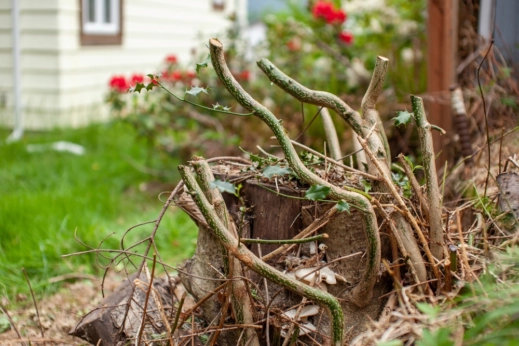
Holly reproduces prolifically; many parts of one tree can make new hollies. (Photo: Shutterstock)
But the forests of St. Edward weren’t the only woods where holly spread exponentially. In August, 18 years after Gray published his analysis of invasive species, I asked him over Zoom if he had since tested his prediction that holly would spread in the Northwest’s shaded woods. He hadn’t, but was willing to take a look.
With input from Stokes, Gray crunched two decades of Forest Service data on holly in Washington and Oregon. The surveys were taken from 2001 to 2009 and 2010 to 2019.
When Gray looked at all 87 of the forest plots that had holly in either decade, he found a 108 percent increase of holly cover in Oregon and 105 percent in Washington. Over 10 years, the holly spread had roughly doubled.
When he looked at plots with at least 50 percent tree cover—shade—the increase was starker: 143 percent increase in Oregon and 119 percent in Washington.
Gray’s analysis of this publicly accessible data has not gone through a formal peer-review process, but I sent it to Stokes for his opinion. Stokes noted the differences in their methodology, but said that Gray’s findings broadly confirmed his own conclusion that holly spreads exponentially in closed canopy forests. Gray’s data provides further evidence that holly’s rate of spread “is very rapid relative to ecological time scales,” Stokes wrote to me in an email. The relatively slow growth of holly in the forest compared to that of the weeds more often seen near places used by humans has kept it from getting as much attention as, say, Scotch broom or tansy ragwort.
“Invasion will take place more slowly on human scales,” Stokes said. “It’s when you consider that a forest takes 200, 300, 500 years to mature—it’s happening quickly.”
IN THE MID-TO-LATE 1800s, European settlers planted the first hollies in the Pacific Northwest, perhaps as a reminder of home. A Dutchman named Jan Bajema, for example, sailed to New York City in 1893. He changed his name to John, settled on a farm in north Washington, fathered 15 children, and, according to one grandchild, planted several holly trees.
In the 20th century, US demand for Christmas wreaths skyrocketed. A few entrepreneurial farmers in the Northwest wagered that English holly could make them wealthy. The region benefited from “an exclusive monopoly,” as one grower put it. English holly, as its name implies, thrives in a temperate, wet climate. The lowlands of western Washington and Oregon are its Goldilocks zone.
By the 1940s, Washington and Oregon were supplying the vast majority of holly shipped in the US Farmers saw it as a safe investment, and nurseries marketed holly as a retirement plan. “Plant a holly orchard and let nature do the work for you,” read one brochure. By the end of the decade, an estimated 300 acres of western Washington were dedicated to holly.
It’s unclear whether this marketing inspired either John Bajema’s third son, Dingeman, who started a holly farm along the Columbia Gorge after a career as a schoolteacher, or Dingeman’s son Ken, who spent many weekends and evenings as a teenager helping his father harvest holly branches during the cold, wet winters. “The worst weather of the Pacific Northwest,” he told me over the phone.
“Invasion will take place more slowly on human scales. It’s when you consider that a forest takes 200, 300, 500 years to mature—it’s happening quickly.”
After a long career in the federal government, Ken Bajema retired in 1988, returned to his childhood home, and picked up where his dad left off: Harvesting, cutting and shipping holly branches to customers across the US. There were about 50 growers in Washington and Oregon then, and the industry brought in millions of dollars annually.
The same year Bajema started farming, he also volunteered to serve on the Skamania County Noxious Weed Board, which regulates unwanted plants in his county. In 2005, Bajema also joined the Washington State Noxious Weed Board, the governing body that decides which unwanted plants counties can regulate.
Bajema kept his private and public business separate for many years. But then his two worlds collided.
In January 2011, fresh off harvest season, Bajema traveled north to Olympia, walked past the grand columns of Washington’s neoclassical Capitol, and took a seat before the state House Agriculture and Natural Resources Committee.

In the 20th century, US demand for Christmas wreaths skyrocketed. (Photo: Ali Edwards/Flickr)
The fall before the hearing, officials in King County (which includes Seattle) sent a proposal to the Washington State Noxious Weed Control Board asking Bajema and his colleagues to add English holly to its official list of regulated weeds.
“Holly, a longtime tradition at Christmas, has taken a bum rap from activist groups for several years in news articles, publications, word of mouth and hearsay,” Bajema told the lawmakers, apparently referring to conservationists’ warnings about holly’s invasiveness.
So, Bajema, holly farmer and holly regulator, donned yet another hat: holly lobbyist. As secretary of the Northwest Holly Growers Association, he launched an aggressive defense of his crop. Holly farmers dismissed claims of its invasiveness while extolling its value to the economy. Although the board’s proposal would not have banned commercial production, farmers said that merely associating “holly” with “weed” could hurt sales.
Their campaign succeeded: The nine board members voted unanimously to keep English holly off their big list of bad weeds, citing the need for more empirical evidence.
A WEED IS JUST A PLANT out of place, or so the saying goes. From the late Middle Ages until very recently, “out of place” meant anywhere that might inconvenience agriculture: “The noisome weeds, which without profit suck; The soil’s fertility from wholesome flowers,” as the Gardener said in Shakespeare’s Richard II.
In 19th century America, industrialization brought new weeds to new places. Seeds crossed state lines as stowaways on trains or carriages. Farmers discovered new thorns, literally, in their sides and in their fields. And states began passing “seed laws” to target unwanted plants.
This approach to weeds, centering humans and ignoring the environment, was still mainstream when President Gerald Ford signed the Federal Noxious Weed Act of 1974, creating a Federal Noxious Weed List that regulates interstate and international commerce. Today, more than 100 species of plants are federally regulated; another 600 or so are controlled by state authorities.
Washington’s Noxious Weed Control Board resembles most of its cohorts in that it sprang from agricultural interests. When the Legislature created the board in 1969, lawmakers defined “noxious weed” as any plant that harms “crops, livestock, or other property.”
“This is a worst-case scenario. But it could get even worse.”
It wasn’t until the 1990s that agencies caught up with increasing scientific interest in ecological invasions. The state noxious weed board became the de facto invasive plant regulator. Now, “out of place” included forests, wetlands and wild prairies, as well as farms and ranches. Washington codified this change in 1997, when lawmakers expanded the legal definition of noxious weed to consider impacts on “natural resources.”
Trying to advance ecological goals through regulations that favored agricultural systems proved ineffective. “Weed laws developed as a reaction to potential economic development,” Bryan Endres, a professor of agricultural law at the University of Illinois, told me. In 2013, Endres helped author a paper in the journal Bioscience showing that weed regulators heavily favor listing agricultural pests over ecological ones.
Such was the situation in 2011, when Bajema lobbied lawmakers to prevent holly from ever again appearing before the noxious weed board. It wasn’t enough that the industry had already kept holly off the noxious list; Bajema was hurt that the state board had even considered the question. “The damage to our industry has already begun,” Bajema told the House Agriculture Committee. “Once an allegation is made, your crop is guilty.”
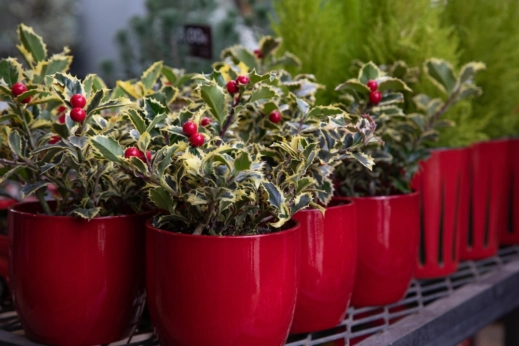
Ornamental holly starts. (Photo: Shutterstock)
Working with the Washington State Farm Bureau, the holly lobby pushed a bill that would have banned any commercially grown crop from being listed as a weed. That was a nonstarter for state weed officials. A compromise bill, eventually signed into law, said that new scientific research on a plant’s invasiveness would have to be published before it could be brought to a second noxious weed vote.
The slow pace of science guaranteed that the growers had bought themselves time. Stokes’ study would not be published for another three years. But it would take much longer for the Noxious Weed Control Board to consider listing holly again.
IF YOU ASK HOLLY WATCHERS why they’re so worried, they’ll often point to an overrun section of forest— a total hollypocalypse—in a fenced-off area in the suburbs south of Seattle.
On a damp morning this August, I met Zoe Loutos, a restoration ecologist for Seattle Public Utilities, in a parking lot outside the fence. We were joined by Jamie Trotto, an invasive species technician, professor David Stokes and Elliott Church, his former research assistant.
Beyond the fence and restricted-access signs lay Lake Youngs, a reservoir that provides treated drinking water to the Seattle metro area. The lake is surrounded by 2,000 acres of forest. Access to the woods is restricted to Lake Youngs staff. We planned to visit a section on McElhoe Peninsula, which is named for 19th century homesteaders, though Loutos calls it “Holly Peninsula.”
“It’s a legend,” Church said. Neither he nor Stokes had been there. “You see the pictures and go, ‘Wow.’”
Church, who’d been Stokes’ lab assistant over 10 years ago, continued to research English holly, completing a master’s thesis on the plant in managed timber forests in 2016. Now 32, he works as an arborist. On the day we met, Church wore his hair in a bun, binoculars around his neck and a wool Forest Service jacket from eBay.
“You’ll have to tell me if it’s worse than St. Edward’s,” Loutos said, wearing a neon orange safety vest and a gray baseball cap embroidered with a hummingbird. Loutos led a three-car caravan through a gate and onto a dike road encircling a lake larger than Disneyland.
Before we entered the forest, Loutos reminded us that Lake Youngs was closed to the public. Nobody seemed to know for sure exactly how long it had been closed, though Loutos thought it had been since the 1920s, when a dam was built to increase the lake’s capacity; that would suggest that birds introduced holly to the area rather than humans. In any case, the limited access makes it a poster child for a holly infestation unmitigated by human intervention.
“Anyway,” Loutos said. “Should we walk into the woods?”
She led us up a short incline. Our boots squeaked against wet salal, while damp shrubs brushed our pants, soaking them. And then we emerged into what Loutos aptly called a “sea of holly.”
We saw holly to our left and holly to our right: 20-foot-tall trees dappled in beams of sunlight. Ankle-biter hollies congregated below us, and tangles of branches blocked the light; at times it was nearly opaque, nothing but bare ground underneath. Partially felled holly trees grew at angles, like javelins thrown by gods. Impenetrable thickets obscured our view. We saw sick hollies with yellowish-brown splotches on their leaves, but very few dead ones.
“This is a worst-case scenario,” Stokes observed, carrying a meter stick that doubled as a hiking pole. “But it could get even worse.”
“You got these guys filling in between,” Church added, pointing to a cluster of young saplings. The retired professor and his former student bounced ideas off each other as if they were back in the classroom.
“In this case, you wouldn’t have a complete replacement of vegetation because it’s Douglas firs above the holly,” Stokes said. “Holly’s never gonna get that tall. But the whole understory, instead of being native plants, you’ll have holly.”
“Holly would be in a position to really dominate,” Church agreed. If a forest disturbance, like a storm or fire, wiped out a chunk of the overstory, “it could change that successional trajectory.” Translation: It could become a holly forest.
“The other thing that we never really addressed is the potential for holly to be a ladder fuel,” Stokes added. In a 2022 wildfire risk study, King County cited holly as a “flammable thicket-forming understory shrub” that could carry flames upward.
In recent years, wildfires in the Pacific Northwest have become more frequent and intense, a trend that will likely continue with climate change.
The scientists tossed out hypotheses and imagined experiments. Could they replicate their St. Edward study here, on Holly Peninsula? Maybe compare the age of the hollies with Douglas firs to determine which came first? What changes would they notice in holly if they moved from the outer edge of the forest inward?
Church was most excited about the sickly holly. He walked quickly, as if spellbound, to a plant with graying shoots and yellowing leaves. Palming a cluster of leaves in one hand, he snapped a photo with his phone. “It’d be great to get some cuttings to a lab and get some analysis,” he said. (Seattle Public Utilities would first need to sign off on any kind of scientific collection, so no collecting was done that day.)
A few meters away, Stokes was examining a plant with crinkly brown leaves and a desiccating stem.
“Is that a holly that’s totally dead there?” Church shouted to Stokes. We descended on the tree. Stokes’ voice lifted multiple octaves. “Check this out,” he trilled. He pointed at a fresh sprout, shooting out from the holly’s lifeless stem.
“It’s suckering from a dead—” Loutos said.
Stokes finished her sentence: “—from a dead tree!”
IN THE SPRING OF 2022, private citizens emailed the Washington State Noxious Weed Control Board, urging it to label holly as a noxious weed. That set the stage for another vote.
Eleven years had passed since Ken Bajema successfully campaigned to stop King County from listing holly. Conservationists had reason to be more hopeful this time; Stokes’ research lent scientific legitimacy to all the anecdotal evidence of a holly invasion.
At Bajema’s suggestion, weed board staffers worked with the state attorney general to add the term “feral holly”—meaning not intentionally planted by humans—to Washington’s administrative code. The proposed listing would cover only “feral holly” and explicitly exclude holly grown on farms or for ornamental purposes.
Bajema had returned to the board in 2018 after several years away, reprising his role as holly’s defender.
He didn’t think much of the new research. “Dr. Stokes has a hatred for holly,” Bajema told me. “He’s been after holly for 20 years.”
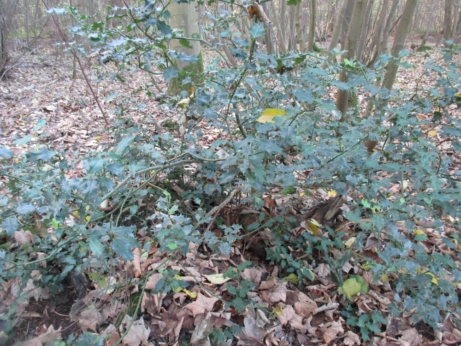
English holly in a forest. (Photo: Shutterstock)
During one September meeting held on WebEx, Bajema tried to shut down the holly-listing effort by invoking the law he helped pass in 2011. He claimed, inaccurately, that “there is no peer-reviewed scientific evidence to prove that holly is a noxious weed.” A staffer corrected him, noting that at least two such articles had been published since the last vote.
“I don’t recall the Holly Society of America or the Horticultural Society signing off on those peer reviews,” Bajema replied. (Industry groups do not take part in the multi-step, anonymous peer-review process for scientific journals).
Stokes, Church and Andrea Watts, another researcher who wrote a master’s thesis on holly, presented their findings to the board. Stokes left one meeting thinking, “Well, this is a slam dunk.”
The vote fell on Nov. 2, 2022. Though two members were absent, there was a quorum, and the director called the roll:
Ken Bajema, holly grower: Nay.
Jerry Hendrickson, former rancher: Nay.
Allen Evenson, weed inspector: Yea.
Carey Caruso, beekeeper: Nay.
Janet Spingath, habitat restoration specialist: Yea.
Bill Agosta, retired chemist: Yea.
A tie means no. English holly remained unlisted in Washington.
Bajema’s victory seemed complete—for about a year. In response to several complaints over his clear conflict of interest, the board passed a new rule barring any of its members from voting on proposed weeds in which they have a financial interest. This time, only Bajema voted Nay.
THIS OCTOBER, Henry Mustin and I returned to Island Center Forest to check on our poisoned holly tree. Mustin, who’d spent the morning clearing holly in another park, wore raingear. I lacked his foresight and was once again doomed to soaking-wet jeans.
Fall was in full swing. Fern tips were turning brown and crinkly. Baseball-sized mushrooms poked out of the ground along the trail. My eyes, now trained, locked on all the hollies, evergreen standouts in the senescing understory.
After less than half an hour and a couple GPS consults, Mustin spotted our tree. It was a skeleton of its former self, its top completely devoid of leaves and its body thinned out, emaciated. Brown leaves sagged from the tips of branches, and most of the berries had dried up like prunes, black and wrinkled.
“It’s been a very effective injection,” Mustin said.
Then I saw the saplings surrounding our tree, all very much alive. To truly eradicate this colony, we’d have to return to Mustin’s trunk, grab more tools, and get our hands dirty again.
I thought of all the berry-bearing hollies still in this park. Poisoning our tree was relatively pain-free, but controlling thicker growths requires trimming, digging, wrenching, crawling, lifting and pulling. It’s back-breaking, blood-drawing labor, often performed on hands and knees by underpaid 20-somethings just starting out in natural resource management. Or by the Henry Mustins of the world, volunteer “weed warriors,” the term used by stewardship groups who have found their calling in preserving natural habitats.
No one has calculated how much public money has been spent controlling holly in the Northwest. Washington State Parks spent more than $30,000 removing holly at St. Edward State Park after David Stokes studied that invasion. When Sally Nickelson, the former invasive species manager for Seattle Public Utilities, discovered the holly at Lake Youngs, the agency approved around $90,000 of taxpayer dollars for control work. Those efforts—and many more tucked within local budgets and contracts—merely snip at an exponentially branching problem.
Even when holly hunters do defeat an invasion, keeping new hollies out requires constant vigilance and optimism.
During our field trip to Lake Youngs, Zoe Loutos described the “hamster-on-a-wheel” nature of her job. “That’s a familiar feeling for me and honestly keeps me motivated,” she told me. When Loutos tackles holly in the Cedar River Watershed, another natural area under her watch, she envisions Holly Peninsula as the disaster she’s working to prevent. “I’m one piece of the puzzle. And even my little contribution is still meaningful.”
Mustin represents another piece of the puzzle. He is credited with removing hundreds of hollies on Little Si, a small mountain and popular hiking spot east of Seattle. (On a recent hike there, I didn’t see a single holly.) During our walks in Island Center Forest, Mustin often mused that a similar effort could work here. “It’s not an impossible task for even a few people to just stop it,” he said.
Weeks later, I returned to our poisoned tree with gardening gloves and a weed wrench and yanked out the surrounding holly saplings. Following restoration best practices, I hung the freshly unearthed invaders on a nearby tree, keeping their roots away from the damp soil, ensuring they would stay dead.
Steven Hsieh is a freelance journalist, formerly of the Santa Fe Reporter, Phoenix New Times and The Stranger. He also owns a small vegetable farm with his partner.
This story was originally published Dec. 1, 2023 at High Country News. High Country News is an independent magazine dedicated to coverage of the Western US. Subscribe, get the enewsletter, and follow HCN on Facebook and Twitter.
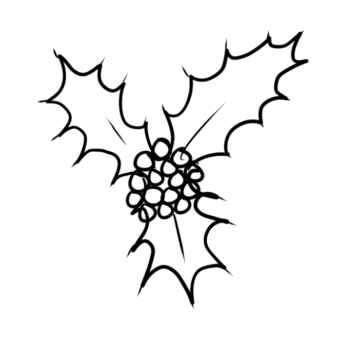

As someone deeply concerned about invasive species and is currently managing them on my own property, I recognize the gravity of the holly situation as described in the article but cannot agree with the ‘renegade citizen scientist’ approach that Mustin has embraced. “We walked until we found a tree not already flagged for removal by county workers.” Clearly there was a management team already in place that could have been notified of the un-flagged tree; there was no need to illegally apply herbicide in a public park. Imidazolinones are non-selective herbicides that can persist in the soil, be transported via… Read more »